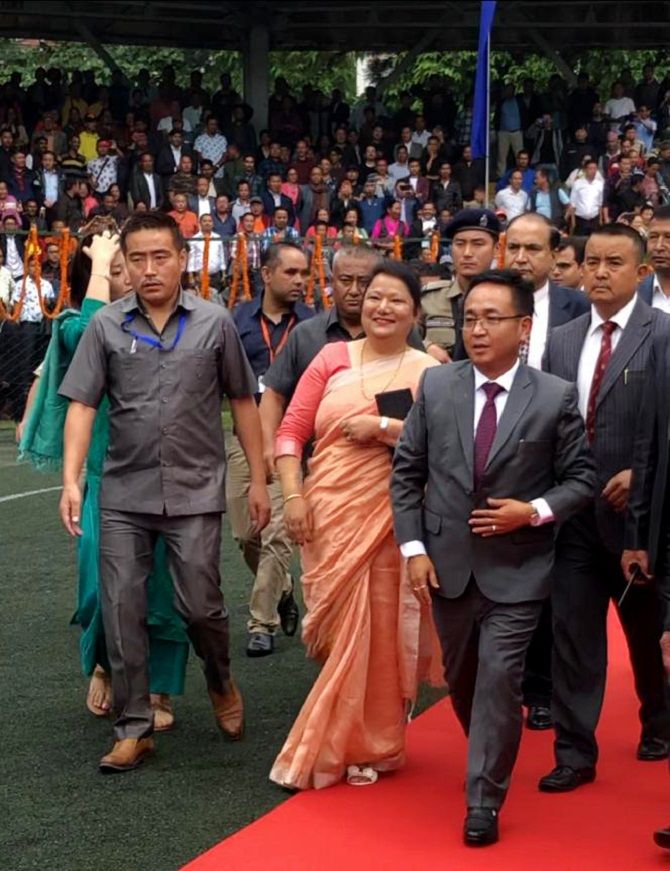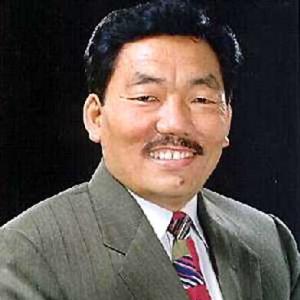Sikkim's new chief minister will have to achieve growth without compromising nature.
Aditi Phadnis reports.

The magnitude of the political earthquake in Delhi obscured another one, elsewhere in India -- in Sikkim.
Pawan Kumar Chamling, India's longest serving chief minister, was dethroned along with his party, the Sikkim Democratic Front.
Chamling first became chief minister in 1994 and stayed in office, ruling with an iron hand and introducing many initiatives with virtually no opposition.
The opposition came in February, 2013, in the form of the Sikkim Krantikari Morcha led by the colourful Prem Singh Tamang, otherwise known as P S Golay.
Golay has had a chequered past. He was a founding member of the SDF and a member of all but one of the governments Chamling headed. He then quit on the grounds of rising corruption and nepotism in the SDF to form his own party.
In 2009, Chamling won all 32 assembly seats in Sikkim but in 2014, he lost 10 seats to the SKM, getting only 22 out of 32.
Soon after Golay formed his party, he got a visit from the state government's vigilance department -- presumably on instruction from Chamling -- regarding misappropriation of government funds amounting to Rs 9.5 lakh meant for distributing cows to beneficiaries under a state government scheme.
This was an investigation dating back to 2010. A chargesheet led to a court case and conviction with a jail sentence and a fine.
Despite a corruption conviction, it is a mystery how he was allowed to contest again.
When he came out of jail in 2018, he was given a hero's welcome, normally reserved for political prisoners.
His party has a majority of just two seats in the Sikkim assembly.
Sikkim itself has a complicated history and it is sometimes hard to tell the villains from the heroes in India's annexation of Sikkim.
The way the first dewan of Sikkim, John Lall, described it, instead of honouring Sikkim's sovereignty and China's feelings, India imported mobs of Nepali-speaking people from Darjeeling and Kalimpong, told the Chogyal that his people had rebelled against him and annexed Sikkim.
Chamling, however, says (possibly because he is a Nepali-speaking native of Sikkim) that the original Lepcha settlers of Sikkim who were subjugated for three centuries by Bhutia tribals from across Tibet perpetuated feudal systems and denied other tribals like Limbus and Tamangs, equal rights.
According to Chamling, the rebellion against the Chogyal was actually a revolution that overthrew oppressive Qazi rule and radicalised scores of young men across Sikkim.
Once he became chief minister, Chamling realised that he had to create his own constituency. He fought to extend reservations to castes like Limbus and Tamangs among the Nepali-speaking population of the state.
In Sikkim, 20 per cent of the population is Bhutia-Lepcha and 40 per cent comprises Other Backward Classes.
Limbus, Rais and Tamangs are around 20 per cent of the population. When they were included in the reservation net, they became Chamling's natural constituency.
P S Golay is a Tamang. He challenged Chamling on issues of nepotism and corruption, and also administrative inefficiency. The very castes Chamling thought he was empowering turned against him.
Golay's campaign got traction.
Sikkim's icon and famous footballer, Bhaichung Bhutia, also floated a party, Hamro Sikkim, ahead of the elections.
India heard about Sikkim's dark side: Corruption, drug addiction and mental illness.
The state has just over six lakh people, but unemployment is high.
It also has the highest suicide rate -- 37.5 per 100,000 people, nearly triple the Indian average.
Seven out of 10 teenagers in Sikkim abuse pharmaceutical drugs. One person in every family is involved in substance abuse.
Though Hamro Sikkim did not win any seats, the problems it highlighted remain -- and are Golay's headache now.
Golay (whose election affidavit, among other things, declares he has been married thrice; it mentions no divorces) will have to beat Chamling's record of growth and development.
The erstwhile planning commission statistics tell us Sikkim recorded the steepest decline in poverty ratio the country has seen: From 30.9% in 2004-2005 to 8.2% in 2011-2012.
You only have to read the 2014 Sikkim Human Development Report produced by a UNDP affiliate to understand the miracle. The HDR 2014 says between 2001 and 2012, Sikkim's net state domestic product grew, on an average, by 17% every year -- the highest among all Indian states -- surpassing significantly the national average of 10%.
Sikkim has said 'no' to 13 hydel projects because they could have threatened the state's ecosphere. The alternative model of development is 'back to nature'.
The state uses no chemical fertiliser whatsoever. Its orchids are world famous. The result? A Royal Bengal tiger was sighted in Sikkim in December, 2018, the state's first, and unusual at an altitude of more than 10,000 feet.
Prem Singh Tamang (Golay) will have to achieve growth without compromising nature.











